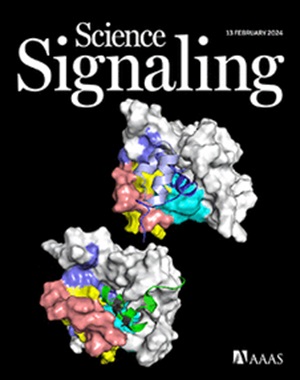新嘌呤合成酶 Adssl1 促进心肌细胞增殖和心脏再生
IF 6.7
1区 生物学
Q1 BIOCHEMISTRY & MOLECULAR BIOLOGY
引用次数: 0
摘要
新生儿心脏在短时间内具有增殖能力,可以完全修复损伤,但这种能力在成年后就会丧失。心肌梗塞(MI)后,通过重新激活细胞周期再通路诱导成人心肌细胞增殖,可改善心脏功能。新嘌呤合成是细胞增殖的关键核苷酸来源。在这里,我们利用功能缺失和功能获得的遗传方法,探讨了肌肉特异性嘌呤合成酶 Adssl1 在心脏再生中的作用。在小鼠新生儿心脏中缺失 Adssl1 会减少心肌细胞的增殖,减弱心尖切除后的心脏再生。相反,心肌细胞特异性 Adssl1 的过表达可延长出生后的再生窗口期,并在心肌梗死后诱导强大的细胞周期再入,从而减少纤维化瘢痕的大小并改善心脏功能。RNA 测序分析表明,Adssl1 的过表达诱导了强烈的去分化和细胞周期进入。此外,LC-MS/MS分析表明,Adssl1的过表达与嘌呤代谢物(包括临床使用的肌苷)的增加有关。给予外源性肌苷可促进成年小鼠心肌梗死后的心脏修复。在分子水平上,由 Adssl1 介导的嘌呤代谢物产量增加增强了促进增殖的 mTORC1 通路的活性。我们的研究确定了 Adssl1 在支持心肌细胞增殖和心脏再生中的作用。本文章由计算机程序翻译,如有差异,请以英文原文为准。
The de novo purine synthesis enzyme Adssl1 promotes cardiomyocyte proliferation and cardiac regeneration
There is a short window during which the neonatal heart has the proliferative capacity to completely repair damage, an ability that is lost in adulthood. Inducing proliferation in adult cardiomyocytes by reactivating cell cycle reentry after myocardial infarction (MI) improves cardiac function. De novo purine synthesis is a critical source of nucleotides for cell proliferation. Here, using loss- and gain-of-function genetic approaches, we explored the role of the muscle-specific de novo purine synthesis enzyme Adssl1 in cardiac regeneration. Deletion of Adssl1 in mouse neonatal hearts reduced cardiomyocyte proliferation and attenuated heart regeneration after apical resection. Conversely, cardiomyocyte-specific Adssl1 overexpression extended the postnatal regenerative window and induced robust cell cycle reentry after MI, which decreased fibrotic scar size and improved cardiac function. RNA sequencing analysis suggested that Adssl1 overexpression induced strong dedifferentiation and cell cycle entry. Moreover, LC-MS/MS analysis showed that Adssl1 overexpression was associated with increased amounts of purine metabolites, including inosine, which is in clinical use. Administration of exogenous inosine promoted cardiac repair after MI in adult mice. At a molecular level, the increase in purine metabolite production mediated by Adssl1 enhanced the activity of the proliferation-promoting mTORC1 pathway. Our study identifies a role for Adssl1 in supporting cardiomyocyte proliferation and cardiac regeneration.
求助全文
通过发布文献求助,成功后即可免费获取论文全文。
去求助
来源期刊

Science Signaling
BIOCHEMISTRY & MOLECULAR BIOLOGY-CELL BIOLOGY
CiteScore
9.50
自引率
0.00%
发文量
148
审稿时长
3-8 weeks
期刊介绍:
"Science Signaling" is a reputable, peer-reviewed journal dedicated to the exploration of cell communication mechanisms, offering a comprehensive view of the intricate processes that govern cellular regulation. This journal, published weekly online by the American Association for the Advancement of Science (AAAS), is a go-to resource for the latest research in cell signaling and its various facets.
The journal's scope encompasses a broad range of topics, including the study of signaling networks, synthetic biology, systems biology, and the application of these findings in drug discovery. It also delves into the computational and modeling aspects of regulatory pathways, providing insights into how cells communicate and respond to their environment.
In addition to publishing full-length articles that report on groundbreaking research, "Science Signaling" also features reviews that synthesize current knowledge in the field, focus articles that highlight specific areas of interest, and editor-written highlights that draw attention to particularly significant studies. This mix of content ensures that the journal serves as a valuable resource for both researchers and professionals looking to stay abreast of the latest advancements in cell communication science.
 求助内容:
求助内容: 应助结果提醒方式:
应助结果提醒方式:


